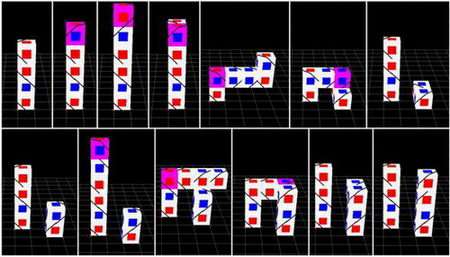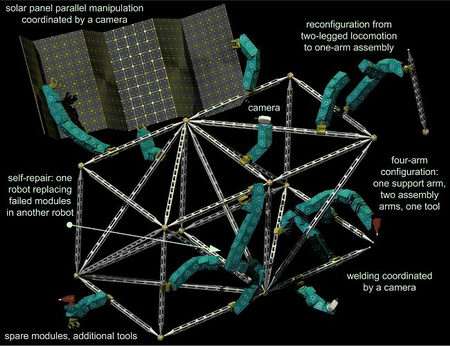June 5, 2007 feature
Simplicity may be key to robotic self-reproduction

“Self-reproduction is one of the remarkable feats of biological systems which has remained largely outside the scope of capabilities of traditional engineered systems,” explains Victor Zykov and his colleagues from Cornell University in a recent study in IEEE Transactions on Robotics.
Zykov, Efstathios Mytilinaios, Mark Desnoyer, and Hod Lipson have examined the meaning of such concepts as “self-reproduction” and “evolution” when applied to non-living machines.
The engineers designed and built a set of modular robots that can be combined into machines of varying sizes that will in turn be able to construct identical copies of themselves. The group experimented with both physical and virtual machines that were manually designed to self-reproduce, as well as self-reproducing machines that were artificially evolved. In the future, self-reproducing machines could be essential for applications prohibiting human maintenance.
“Ultimately, artificial evolution will be used to design the bodies of real 3D self-reproducing machines, as well as the procedures for their construction by available, pre-assembled modular robots,” Zykov explained to PhysOrg.com. “Next, these self-replication programs will be uploaded on available robots that will physically construct the new robots—or self-reproduce.”
Zykov said that designing the sequences for the evolving self-replication of 3D robots is currently very difficult, which is why the team designed evolving self-replicating programs for 2D modular robots. Also, to prepare for automating the design and control of 3D self-replication, the scientists performed 3D manual experiments to demonstrate the practical feasibility of evolving 3D self-replication.
The set-up of the manual process resembles a 3D Tetris game, where a dispenser drops cubic modules, called “Molecubes,” to a machine consisting of a line of connected cubes that can pick up, hold, and drop other cubes, as well as swivel to place a cube in a different location. Ultimately, the original machine can be programmed to build a copy of itself, which in turn can copy itself, ideally through several generations.
Each Molecube is identical: a 10 cm3, 625-gram module that can swivel along its long diagonal axis. On two of the cube’s sides, connectors can attach to other cubes’ connectors. A servo motor within each cube drives the swiveling mechanism.
The goal of the second part of the project was to find out whether or not it is possible to artificially evolve simple modular 2D self-reproducing machines with 2D Molecubes. First, the genetic algorithm searches for a specific shape of a 2D machine. The desired shape should enable the robot to pick up available modules around itself, swivel to a target location, and, by sequentially dropping the modules off one by one in the right places, form an exact 2D replica of itself.

During the second stage of the process, the evolution searches for a sequence of actions that would enable the resulting robot to achieve self-reproduction. Eventually, three different 2D robots were evolved that were able to create complete replicas of themselves.
While this is not the first physical self-reproducing robotic system, there are relatively few other self-reproducing systems, and they generally use more complex mechanisms than Molecubes. The simplicity of the demonstrated building blocks suggests that it may be easier to self-reproduce for those complex systems that are constructed from many simple and identical units.
The engineers note that biological organisms are all built from a repertoire of only 20 types of amino acids; however, the complete organisms can contain up to 1020 individual molecules of these amino acids. This comparison suggests that self-reproduction in biological organisms may also tend to employ simple and similar building modules.
Zykov said self-reproducing robots may have applications in future long-term robotic space exploration missions.
“Imagine a long space mission where we cannot predict some of the specific problems that it will face,” he said. “In this case, we also cannot foresee what types of robots will be necessary to solve those unanticipated problems. However, we can fill any available space onboard the spacecraft with spare Molecubes, and also include one or two assembled robots with them.
“Now, if the mission faces an unforeseen problem, the evolutionary algorithm onboard the spacecraft can be used to evolve a body shape for a robot that will be suitable to solve that problem,” he continued. “Once the shape of the desired robot is known, the functional robots onboard the spacecraft will assemble it from the spare Molecubes. We hope that, in the future, such universally adaptable robotic systems will help to avoid tragedies similar to the one that ended the lives of the seven astronauts during the final mission of Space Shuttle Columbia.”
Another question the scientists addressed in their research is the fundamental concept of “what counts as self-replication.” They have developed a metric that captures dimensions such as quality, rate, external material required, and probability of emergence of a replicating entity in various environments, and collapsed these aspects into a single quantified continuum based on the amount of information involved in replication.
“In judging whether or not self-replication has occurred, multiple criteria can be used: the degree of similarity between the original and the replica, the amount of help from the environment used by the original in the process of self-replication, the complexity of the replicating entity relative to its constituent parts, etc.,” Zykov explained.
“If we consider self-replication to be a binary property, that it is either true or not true for every specific case in consideration, then a judgment must be made about whether self-replication has or has not occurred using the criteria above,” he said. “However, for each of these criteria, there is no clear cut boundary that would separate self-replication from non-self-replication, so making a yes/no decision is not easy.”
When viewing self-replicating as a continuous property, however, the value of self-replication would be different for each specific case of self-replication.
“This value will be smaller for those cases of self-replication that result in imperfect replicas, require very specific environmental conditions or significant assistance from the outside, or involve a very simple self-replicating agent. For example, an animal would have a much greater value of self-replicability than a simple two-part robot, as it consists of many more building blocks, can successfully reproduce in a variety of environmental conditions, and doesn’t use an external power supply.”
Hopefully, this metric will provide a common point of comparison to allow improvements in future self-replicating systems.
Citation: Zykov, Victor, Mytilinaios, Efstathios, Desnoyer, Mark, and Lipson, Hod. “Evolved and Designed Self-Reproducing Modular Robotics.” IEEE Transactions on Robotics, Vol. 23, No. 2, April 2007.
Copyright 2007 PhysOrg.com.
All rights reserved. This material may not be published, broadcast, rewritten or redistributed in whole or part without the express written permission of PhysOrg.com.





















